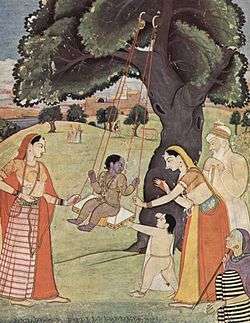Nandvanshi

Nandvanshi is a term designating the descendants of Nanda (also known as Nandagopa). According to the Harivamsha and the Puranas, Nanda was the head of the Gopas, a tribe of cowherds referred as Holy Gwals. Vasudeva took his new-born son Krishna to Nanda on the night of the child's birth so that Nanda could raise him.
Nandvanshi Ahirs
The Nandvanshi Ahirs claim descent from Nanda.
In Rajasthan they are found in Jaipur.[1] Nandvanshi Ahirs are also found in Khandwa and Bhopal in Madhya Pradesh, Aurangabad, Akola, Amravati, Bid, Chandrapur, Jalna, Pune, Nagpur, Nanded, Thane, Wardha and Washim in Maharashtra and Hyderabad in Andhra Pradesh.[2]
The Kaonra Ahirs of Mandla and the Kamaria ahirs of Jabalpur are considered to belong to the Nandvanshi group.
Nandvanshi and Yaduvanshi titles have fundamentally the same meaning,[3] as the sources suggest that Vasudeva, the Yadu King and Nanda, the professed ancestor of Nandvanshi Ahirs were kinsmen or brothers and thus both belonged to a common ancestry and Nanda having no issue had been succeeded only by Lord Krishna, an Yadu Prince.[4][5]
Nandvanshi Ahirs constituted the Martial races, who were socially, religiously and geographically closely related to the groups already recruited in the British Indian Army.[6]
Nandvanshi Gurjars
One section of scholars, including K.M. Munshi, is of the openion that the Gurjars are the original inhabitants of India and are descended from Yadavas or Ahirs.[7][8] A clan of Gurjars even call itself Nandvanshi.[9]
Bharwads
The Bharwads are a Hindu caste found in the state of Gujarat in India who claim Nandvanshi origins.[10][11]
See also
References
- ↑ Kumar Suresh Singh; Anthropological Survey of India (1998). People of India. Anthropological Survey of India. p. 56. ISBN 978-0-19-563354-2. Retrieved 17 June 2011.
- ↑ People of India: Maharashtra - Google Books. Books.google.co.in. Retrieved 2013-10-24.
- ↑ Michelutti, Lucia (2008). "The vernacularisation of democracy: Politics, caste, and religion in India": 114, 115. ISBN 9780415467322.
- ↑ Lok Nath Soni (2000). The Cattle and the Stick: An Ethnographic Profile of the Raut of Chhattisgarh. Anthropological Survey of India, Government of India, Ministry of Tourism and Culture, Department of Culture, Delhi: Anthropological Survey of India, Government of India, Ministry of Tourism and Culture, Department of Culture, 2000 Original from the University of Michigan. p. 16. ISBN 9788185579573.
- ↑ Gopal Chowdhary (2014). The Greatest Farce of History. Partridge Publishing. p. 119. ISBN 9781482819250.
- ↑ Peter Karsten (2013). Recruiting, Drafting, and Enlisting: Two Sides of the Raising of Military Forces Military and Society. Routledge. p. 21.
- ↑ Amir Hasan (1986). A Tribe in Turmoil: A Socio-economic Study of Jammu Gujars of Uttar Pradesh. Uppal Publishing House, Original from the University of Michigan. p. 3.
- ↑ V. Verma (2000). Ban-Gujars: a nomadic tribe in Himachal Pradesh. B.R. Pub. Corp., Original from the University of Michigan. p. 43. ISBN 9788176461122.
- ↑ Omacanda Hāṇḍā (2001). Temple Architecture of the Western Himalaya: Wooden Temples. Indus Publishing, 2001. ISBN 9788173871153. Retrieved 3 August 2014.
- ↑ Sudipta Mitra (2005). Gir Forest and the saga of the Asiatic lion. Indus Publishing. p. 84. ISBN 978-81-7387-183-2. Retrieved 17 June 2011.
- ↑ Rash Bihari Lal; Anthropological Survey of India (2003). Gujarat. Popular Prakashan. pp. 194–. ISBN 978-81-7991-104-4. Retrieved 17 June 2011.